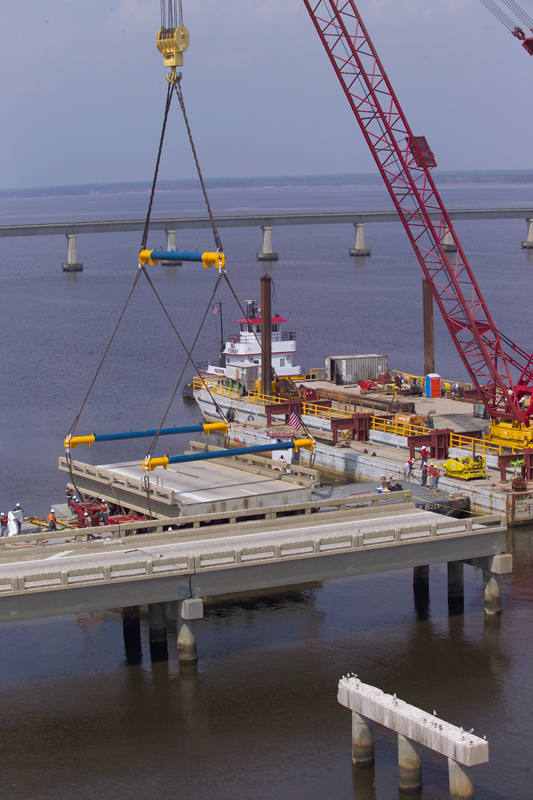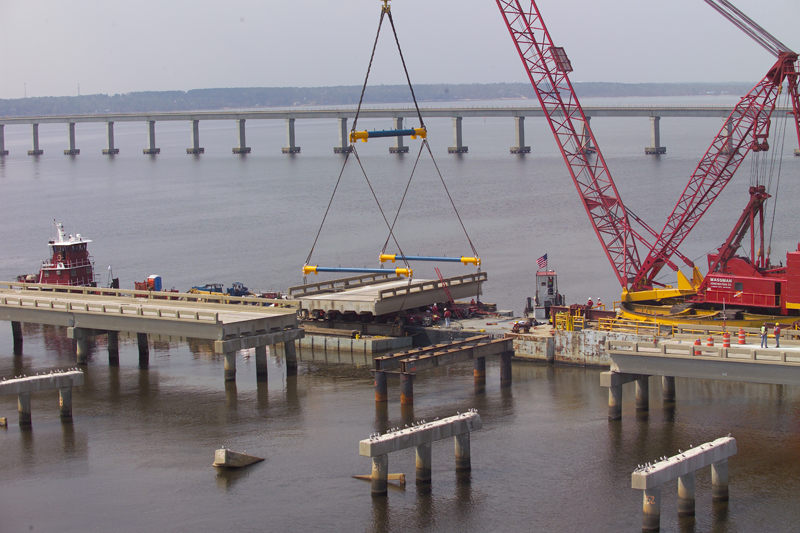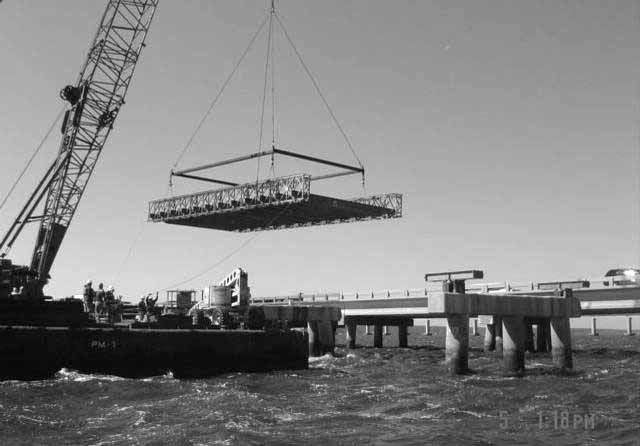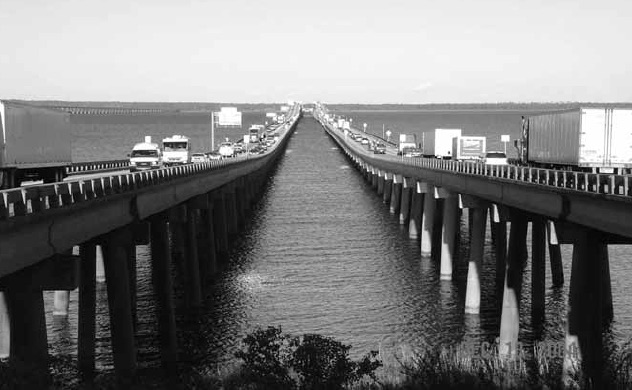State: FL
County:
Owner: State
Location: Rural
Spans: > Three-span
Beam material: Concrete
Max Span Length (ft.): 0
Total Bridge Length (ft.): 3400
Construction Equipment Category: Lateral Slide
ABC Construction Equipment: Towed modular transporter; lateral slide w/pad (skids); High-capacity crane on barge
State ID Number: 580058 / 580071
NBI Number: 580058 / 580071
Coordinates
Latitude: 30.5149994 | Longitude: -87.1483307
Bridge Description
Project Summary:Project Location:
Interstate 10 over Escambia Bay in Escambia County in northwestern Florida
Impact Category:
Tier 4 (within 1 month)
Mobility Impact Time:
ABC: 17-day closure of westbound bridge; 63-day closure of eastbound bridge ; Conventional: Not an option.
Primary Drivers:
reduced onsite construction time; reduced traffic impacts
Dimensions:
3,400 linear feet of bridge
Average Daily Traffic (at time of construction):
0
Traffic Management (if constructed conventionally):
Existing Bridge Description:
The existing bridge consisted of twin structures, each with two 12-ft-wide traffic lanes and two 6-ft-wide shoulders. Built in 1968, the bridge was heavily damaged when Hurricane Ivan struck the Pensacola area. During the hurricane, the impact of the storm surge pushed 58 spans off bridge supports and shifted another 66 spans. Conventional modular transporters on barges and a barge-mounted high-capacity crane were used to repair the bridges. [Note: Construction on a replacement bridge was initiated in 2006 while the existing bridge remained open. The wider (six-lane) replacement bridge was built with higher vertical clearance south of the existing bridge. After the replacement bridge opened in 2007, the original twin structures described herein were demolished.]
Replacement or New Bridge:
Construction Method:
The 2004 repair contract had two construction phases. The westbound bridge was repaired in Phase I, and the eastbound bridge was repaired in Phase 2. In the westbound bridge, a total of 12 spans and seven piers were destroyed, and 19 spans were misaligned. In the eastbound bridge, a total of 51 spans and 25 piers were destroyed, and 33 spans were misaligned.In Phase 1, the contractor drove 28 new piles prior to lifting existing spans off the eastbound bridge and placing them on missing sections of the westbound bridge. Misaligned westbound spans were adjusted and the westbound bridge was re-opened to one lane of traffic in each direction. In Phase 2, the contractor repaired the eastbound bridge with existing spans and 58 temporary Acrow (metal) panel deck spans. It was re-opened to one lane of traffic in November 2004. Permitted and over-sized vehicles were not allowed to travel on the temporarily repaired bridges.Barge-mounted conventional modular transporters assisted in lifting spans off the eastbound substructure so that they could be floated to the westbound bridge side where they were set in place with a barge-mounted high-capacity ringer crane. The transporters on barges were also used to realign spans that had been shifted by the hurricane forces.Phase 1 of the contract required the westbound bridge to be repaired and re-opened within 24 days. An incentive/disincentive clause of $250,000 per day if less than or greater than 24 days was also included. The contractor opened one traffic lane in each direction on the westbound bridge in 17 days, earning a $1.75 million bonus for opening seven days early. Phase 2 of the contract required the eastbound bridge to be repaired and re-opened within 90 days. The contractor opened the eastbound bridge to one lane of traffic in 63 days, 27 days ahead of schedule.
Stakeholder Feedback:
Governor Bush praised the workers involved. He said: “The work that you did makes me and the 16.5 million Floridians proud.”
Lessons Learned:
Because the project site had no electricity or running water, the design-build team and the FDOT staff moved to an office in Tallahassee. The office’s efficient communication and coordination kept the project going 24/7.
High Performance Material:
Project Planning
Decision Making Tools:Site Procurement:
Project Delivery: Design-build; Emergency contract
Contracting: Incentive / disincentive clauses
Geotechnical Solutions
Foundations & Walls:Rapid Embankment:
Structural Solutions
Prefabricated Bridge Elements: Steel pile capsPrefabricated Bridge Systems: RDcBc (Reused concrete-decked concrete beam span); Metal panel deck spans
Miscellaneous Prefabricated:
Costs & Funding
Costs:$26.4 million emergency contract.
Funding Source:
Federal Only
Incentive Program:
FEMA emergency relief funds
Additional Information
On September 16, 2004, the storm surge from Hurricane Ivan dropped 3,400 linear feet of bridge into the bay, causing the bridge to be closed to traffic in both directions. The detour length added at least an hour of travel time for all interstate traffic. On September 17, an emergency repair contract was signed to provide one lane in each direction.
Downloadable Resources
Contract Plans:Specifications:
Bid Tabs:
Construction Schedule:
Other Related Information:
Final-18Maxey
Summary Sheets:
Final-18Maxey
130314_FL_2004_I-10-Escambia-Bay-OriginalRepair
130402_FL_2004_I-10-Escambia-Bay-OriginalRepair
Other Related URLs: Photo Credits:
Florida Department of Transportation; Parsons Transportation Group
Contacts
Robert V. Robertson, Jr.,
P.E.
State Structures Design Engineer
Florida Department of Transportation
Robert.Robertson2@dot.state.fl.us
850-414-4267







